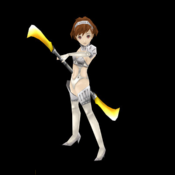oh my. now i have to get this game.
Persona 3 Portable Review
|
|
See PixlBit's Review Policies

On 09/12/2010 at 11:55 PM by Chessa DiMola The third edition of Persona 3 features great tweaks and solid improvements to nearly every facet of the gameplay. |

Persona 3 Portable is hands down the ultimate version of the title and should be the first choice of those new to the game. Fans of the title will undoubtedly enjoy the new additions, especially present in the female quest, though they can only be truly appreciated by those who wish to invest another 70+ hours into the game.
Persona 3 was a game that became one of my favorite titles of all time completely by accident. Thanks to a great sale by Gamestop, I acquired the game free of charge and had no intention of playing more than ten minutes just to see what it had to offer. To my surprise, I was hooked nearly immediately, and soon wondered how ten minutes of inspecting the game turned into an uncontrollable urge to learn more about the characters, the strange world, fantastic combat, and the social link system that added a whole new dimension to the game.

Since its original North American release back in 2007, Persona 3 has been received well among the gaming community, and even gained enough attention to warrant the addition of a 20 hour pseudo-sequel to the main story (know to fans as "The Journey") with the release of Persona 3: FES, called "The Answer". When Persona 4 was released over one and a half years later, many reviewers discussed the new gameplay elements, particularly concerning combat, that would have really benefitted Persona 3. Most notably was the players ability to have full control over their characters' decisions, instead of merely being able to assign a tactic, such as only using physical attacks, conserving SP, focusing on one enemy, or healing.
Apparently Atlus must have been listening, because the release of their latest version of Persona 3, Persona 3 Portable, not only addresses the complaints of many gamers, but adds plenty of great new elements.

For those of you unfamiliar with Persona 3, let me give a quick rundown of the game. You are the main character, a student who has just transferred to Gekkoukan High in the Japanese city, Iwatodai, where strange things occur at midnight, known as the Dark Hour to a select few. During the Dark Hour, most individuals are transmogrified into coffins, leaving them completely unaware of the occurrences during this time. A select few unaffected by the transmogrification process are gifted with the ability of Persona, allowing them to summon beings that will allow them to battle the Shadows that are terrorizing the city. A special group of high school students, known as SEES (Specialized Extracurricular Execution Squad), battle against these creatures in the hopes of destroying them permanently. Your character is among those with the ability who have agreed to help eradicate the Shadows, though your power of Persona is unlike any of the others. Unlike them, your character is able to wield multiple Personas, instead of only one, and learning how to utilize each Persona's skills, strengths, and weaknesses is one of the many important focal points of the game.
Gameplay is structured according to a time system, in this case thirty day cycles. During this time period, all of the main characters in the game must go about their daily lives, after all they are students. Within the thirty day span players are responsible for leveling up their characters, increasing stats (Academics, Charm, and Courage) and establishing social links.

Though Persona 3 is an RPG at its core, leveling up alone will not necessarily ensure success, and this aspect is what initially drew me in. Those that don't want any "complications" in their RPG experience would do well to steer clear, because much more than grinding is required to progress through the game.
Establishing social links within Persona 3 is every bit as necessary as grinding. During the day, as the characters go about their lives, they will have the opportunity to form bonds with one another, whether between the S.E.E.S. team themselves, or individuals inhabiting Iwatodai. Every Social Link follows its own path and is affected by the answers players give along the way, and whether or not the player owns a Persona corresponding to one of the twelve major Arcana that the individual represents. The level of a particular social link grants players an experience boost when they fuse new Personas, and once maxed out allows players to fuse the highest level persona in a particular arcana. Though players will be unable to utilize many of these high level Personas until much later in the game, the combination of several grants the ability to fuse super Personas that will come in handy for particular boss fights.

For a time, the gameplay will follow a general pattern: players will enter Tartarus (the large tower where the Shadows dwell) in order to battle and level up their characters (a party max of four), establish social links during the day and night (when players don't wish to enter Tartarus or their party members are sick), then finish off the thirty day cycle with a strong Shadow boss fight.
That's the gist of Persona 3, and unfortunately my "brief" description cannot possibly cover all of the many other intricate details, nor can it possibly ever convey what an absolutely deep and engaging experience the game is. But after all this is a Persona 3 Portable review, so I must move on.

Unlike its predecessors, Persona 3 Portable now offers an entirely new quest featuring a female lead, and I will be covering the game from that perspective.
The first change that players will undoubtedly notice when switching on Persona 3 Portable is the lack of character animations. Instead, they have been replaced on screen with the familiar character avatars next to a text box, with an image of the location/current situation as the background. Although the animations themselves are absent, and feel a bit missed at first, the change is barely noticed over time, especially with the return of the excellent voice acting. In fact, the only other noticeable everyday change within the game is the lack of ability for players to walk around locations, excluding Tartarus. Instead, all areas outside of Tartarus are either navigated with an on-screen orb or by quickly warping to an area using a sub menu. Such minor changes have absolutely no negative effect on the gameplay experience.

The most notable changes within Persona 3 Portable deal with combat, all of which have been taken from Persona 4. Now, players have complete control over every character in their party, a common complaint amongst players previously. Personally, I never had a problem with not being able to control my characters; not only did it give the characters themselves a more defining identity, but it allowed for some great tactical strategy, as well as an element of uncertainty. Having said that, after trying out full control of my party, it most certainly makes battling easier as players never have to worry about their party members doing something stupid again. Even a fan like me, who will argue to the death that nothing was wrong with the old system, will concede that the new battle system eliminates any situation where frustration may have arose, especially when it comes to boss battles requiring a large time investment.
Other brand new battle elements include the co-op feature, where after knocking down a random number of enemies a party member may offer to help knock down another enemy. This system not only helps defeats enemies quicker but also saves the main character from having to waste any additional SP; a very important detail since HP and SP no longer refill automatically when players return to the main floor of Tartarus. My largest complain with the co-op system, is that it is sometimes triggered when additional enemies will remain standing. Without an additional party member carrying a Persona that has abilities the enemy is weak to, the co-op move is basically useless, as it will eliminate any option for the game's signature All Out Attack move. As annoying as it may be for the move to not trigger at the perfect time, it can definitely be a life saver during some of the later blocks of Tartarus.

Also coming from Persona 4 is the ability for a party character to endure a fatal blow for the main character. While losing an additional party member can put players in a rough position during a boss battle, having the main character die would result in a game over, thus it makes a great addition.
The final new combat addition is the ability to guard. Though I rarely take advantage of this ability, it definitely comes in handy, especially when dealing with a life or death situation.

As any Persona 3 fan may know, Shuffle Times after battle give players an excellent opportunity to boost XP earned in the battle, heal, earn money, gain weapons or even collect personas. In Persona 3 Portable, it seems as though the appearance of vines (which boost XP) have been drastically reduced. In my playthrough of Persona 3: FES, a vine was nearly always guaranteed; however in Persona 3 Portable, their appearance is much rarer, accounting for the necessity to grind more. On the other hand, while vines may not appear as often, there are plenty of different Personas to acquire, another feature seemingly borrowed from Persona 4. Though a wide variety of Personas can now be captured after battle, it does not overshadow the need to fuse personas within the Velvet Room.
Stat cards are yet another new addition and their inclusion allows players to further customize the personas in their arsenal. The stat cards will assign a specific new ability to a persona who may not otherwise be capable of obtaining it.

Though there are still plenty of new additions and difference to discuss, one of the most significant changes I found was the removal of SP and HP recharge upon returning to the bottom floor of Tartarus. Previously, players could spend as much time as they wished in Tartarus, until their characters became tired. Now, characters no longer become tired unless knocked down, and players must either rely on items/persona abilities to heal, items to refill SP, or the clock on the main floor of Tartarus, which will now heal the party for a fee. This small difference may throw veterans for a bit of a loop, as old strategies may no longer work, and an entirely new game plan must be enacted.
Finally, the last difference concerning Tartarus that players will encounter is the new goal system of saving ordinary people who have become trapped inside of the tower. All of the missions are completely optional, and can either be viewed on the board next to the police station in the mall, or delivered as a message to you by Elizabeth. Players will need to visit Elizabeth in the Velvet Room in order to get a general idea of which floors they may be on, and upon finding them, players can return to the police station for a reward. Though these quests are optional, players may find it very interesting that some of the individuals who become lost are their social links. If they do not rescue the person in time, the opportunity to max out that particular social link is gone forever.

Speaking of social links, veterans of the series will not want to miss their opportunity to play as the new female lead. Choosing the female character allows players to experience a completely new variety of social links; not only in the manner in which certain characters, for example the male members of S.E.E.S., interact with her, but also because of several brand new characters that have replaced others for particular social link arcanas. This is not only an opportunity for players to explore brand new characters, but to see a whole new side of some of their favorite party members. Leveling up social links was my favorite part of the game before, and Persona 3 Portable has made it even more enjoyable the second time around.
In addition to the differences in Social Links, the female main character brings a few new elements to the table. Players will now be able to visit Inaba from Persona 4, and get a wonderful glimpse of Yukiko as a young adolescent. There are also fantastic new music tracks to go with the already amazing song selection featured throughout the game and in the male lead's quest.
After nearly completing the game for the second time, I can honestly say that although Persona 3 Portable is nearly identical to its brethren, the additions allow players to experience the game in a brand new way, especially if they select the female quest. For diehard fans of the title, Persona 3 Portable is a must have for the new quest and fantastic additions to the combat system. Those seeking to experience Persona 3 for the very first time can't go wrong with Persona 3 Portable. Although they won't be able to play through the added chapter, The Answer, featured only in Persona 3: FES, the grind-intensive addition won't be missed by most.










Comments